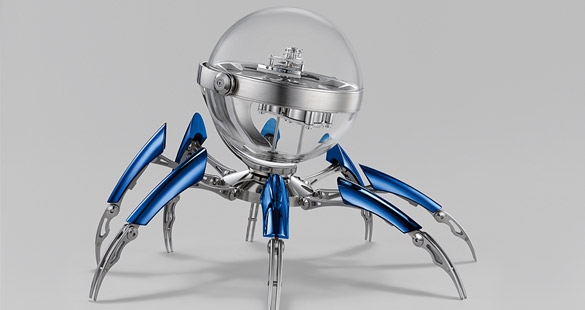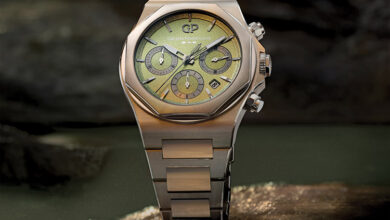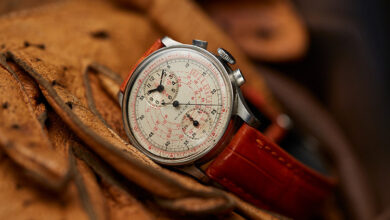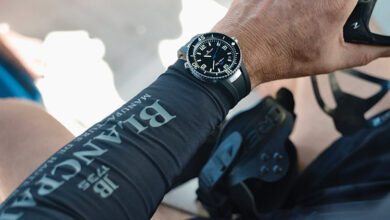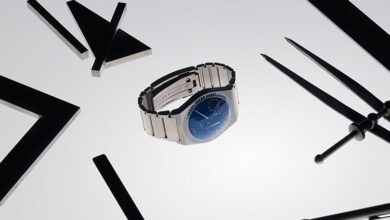MB&F unveils an eight-day Octopod
Horological brand MB&F, which delights in the unconventional, now continues its exploration of aquatic themes with an eight-leg, eight-day clock inspired by cephalopods, marine chronometers, and “The Abyss” – blending contemporary design with kinetic sculpture and a transparent bubble filled with precision horology
Conceived by MB&F and built by Switzerland’s premier clock maker, L’Epée 1839, Octopod stands or crouches thanks to its eight articulated legs. Each leg can be individually adjusted to varying heights, enabling Octopod to rest securely on the most uneven of surfaces, just like a real octopus.
However, the real horological magic and mystery take place in the Octopod’s completely transparent spherical ‘head’. The first thing to notice is that Octopod’s transparent sphere is gimballed in a similar manner that traditional ship chronometers were gimballed – although on one axis rather than two – so that they remained flat despite the pitching and rolling of the ship.
In Octopod’s case, the gimbal ensures that no matter what angle or height it sits, it is easy to rotate the bubble so that the time display inside is at the ideal plane for maximum legibility. The second thing the attentive eye will notice is that Octopod’s pulsating escapement, which regulates the clock’s precision, is located on its minute hand rather than the more usual (and mechanically simpler) position attached to stationary movement plates.
While not technically a tourbillon according to Abraham-Louis Breguet’s original patent, with its movement vertical, the 60-minute rotation of Octopod’s regulator on the minute hand is closer to the primary aim of Breguet’s invention. His intention was to rotate the escapement of a pocket watch sitting vertically in a fob pocket to average out positional errors, while wristwatch tourbillons are continually moving through all positions without requiring 360° rotations.
And the third brainteaser is the mystery of how Octopod’s clockwork is suspended inside its crystalline sphere, so that it appears to be floating in space (or water). The baseplate of the movement is a transparent glass plate that has been treated with a film of anti-reflective coating on both sides so that it is virtually invisible. Like an octopus concealing parts of itself with camouflage, Octopod conceals parts of itself with visual tricks of its own.
Octopod’s eight-day movement is an entirely new development by L’Epée 1839, with both the glass baseplate and counterbalanced regulator posing particular challenges. Along with its octopus and marine chronometer connections to the sea, the Octopod also brings to mind the then-futuristic glass bathysphere of James Cameron’s 1989 film, “The Abyss”.
While the viewer may be outside looking in at the transparent bubble, it’s easy to imagine sinking below the waves and looking out at the astonishing iridescent creatures of the deep oceans. However, you may rest well assured that despite its aquatic inspirations, the Octopod is perfectly at home on dry land.

Inspiration
TheOctopod’s idiosyncratic design derives from three aquatic sources: the highly intelligent octopus with its ‘eight legs’ provided the inspiration for the eight articulated legs, while the gimballed traditional marine chronometer inspired the partially gimballed sphere housing the clockwork and time display. And finally, memories of the bathysphere in “The Abyss” have evolved into the transparent bubble that is the watch case.
The original sketch MB&F gave to L’Epée 1839 showed the movement ‘floating’ inside the transparent bubble, but this was more to allow the manufacture more latitude in developing the support structure for the clockwork, than an expectation that a ‘floating’ movement was actually possible. Not for the first time, L’Epée 1839 went far and beyond the brief to create something even more exceptional than planned.

Realisation
While MB&F came up with the concept and design of the Octopod, it was L’Epée 1839, Switzerland’s premier clock maker, which developed the movement as well as the unusual transparent spherical case and articulated legs. L’Epée produces most of the components, puts them all together and regulates the high precision, eight-day clockwork.
While nothing about this atypical project was easy, L’Epée faced two major challenges. The first was in finding a supplier for the glass baseplate able to work to the tight tolerances required, as companies cutting and drilling glass were not used to working to the extreme precision demanded by horology. The complete movement is mounted on the glass baseplate, so the position of the diamond-drilled holes was of critical importance.
The second significant challenge was in having to adjust the counterweight for the regulator-bearing minute hand in three dimensions. Originally two counterweight screws were thought to suffice, but it was quickly discovered that five minuscule adjusters were necessary to ensure that the minute hand was perfectly balanced for optimal timekeeping precision.
The Octopod is available in three limited editions of 50 pieces each in black PVD, blue PVD, and palladium (silver).



